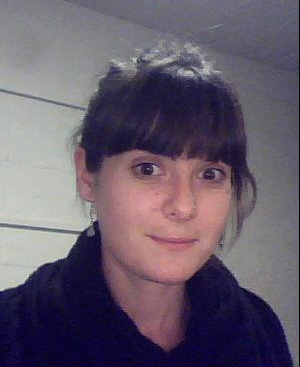Laura Arriaga#
Research InterestsThe current understanding of biomembranes arises mainly from fundamental studies performed on model surfaces such as Langmuir monolayers, supported membranes or vesicles. The central concept of lipid bilayer was actually born from Surface Science when Gorter and Grendel[1], using a Langmuir balance, demonstrated that the lipids extracted from a cell membrane were able to form a two molecules thick layer. Thus, the study of biomembrane mechanics can be grounded on the physical principles of Surface and Colloidal Physics[2],[3]. On this aim, I became program on Science and Technology of Colloids and Interfaces hold at Barcelona University and got the group of F. Monroy to carry out my Ph.D project in Complutense University of Madrid.
During that predoc period, Prof. Monroy trained me on the physics of fluid surfaces, particularly on surface rheology and membrane dynamics at a meso- macro-scopic level, and on the physical chemistry of biomembrane models. As a formative complement, I have received additional scientific training from other experienced researchers in different European laboratories, all of them contributing with complementary skills in physics of colloids and biological membranes. In the context of an extensive collaboration, I spent some time as a visiting researcher in the laboratory of Prof. Thomas Hellweg on the topic of shape fluctuations at the Technical University of Berlin. Prof. Hellweg is a recognized expert in scattering techniques focused on the study of microemulsions, gels, microparticles and soft objects in general. His more recent interests in biological matter converged with our research line on the dynamics of biomembrane models, thus we launched such long term collaboration necessary to explore, prepare, propose and perform complex experiments at international synchrotron and neutron facilities. In particular, we have conducted research on this topic around neutron and synchrotron facilities. As a major result, I must highlight the first successful experiment on the detection of the shape fluctuations of lipid vesicles[4],[5], which has significantly contributed to the better understanding of the bending rigidity of lipid bilayers, and of the intermonolayer friction between both membrane leaflets[6]. Complementary expertise in imaging fluorescence techniques was gained in a further stage with Prof. Bagatolli at Membrane Physics Institute of University of Southern Denmark. Prof. Bagatolli, internationally recognized as an authority in membrane imaging techniques, trained me on confocal and two-photon fluorescence microscopies, both techniques extremely useful for the characterization of lipid domains in giant unilamellar vesicles (GUVs) in particular and for imaging in soft matter objects in general, as well as on the design and manipulation of vesicle structures. Particularly, I worked on the determination of the thermodynamic tie-lines of the two phase coexistence region of different lipid mixtures, which is a powerful predictive tool of phase separation from lipid composition[7].
After my Ph.D, I joined the group of Prof. D. Langevin (Laboratoire de Physique des Solides, Orsay, France) for one-year post-doc. Prof. D. Langevin is one of the most relevant and influent soft matter scientists worldwide, and this stage has been definitive to complete my scientific training on surface rheology and membrane mechanics. We have studied the glass transition in thin polymer films confined at the air/water interface taking advantage of interfacial shear Rheology. The marvelous scientific atmosphere provided by this group allowed me to get involved in other interesting problems, mainly related with foam stability (catanionic and particle-stabilized foams) for which I have been trained in microfluidic techniques.
Currently, I am at Harvard University in the group of Prof. Weitz, where all this know-how will be extremely useful for my new project. I got involved in a very revolutionary concept, the so-called Celloidosome. project (www.ynano.com
 ), in which I am going to design and prepare “Janus”-Celloidosomes following a knowledge-based schema: by controlling membrane composition we will be able to induce lipid phase separation in giant vesicles obtained via microfluidics and then used them as scaffold for the 3D-self-assembly of cells; the Janus structure will allow us to selectively attach various type of cells and study the synergies established between them.
), in which I am going to design and prepare “Janus”-Celloidosomes following a knowledge-based schema: by controlling membrane composition we will be able to induce lipid phase separation in giant vesicles obtained via microfluidics and then used them as scaffold for the 3D-self-assembly of cells; the Janus structure will allow us to selectively attach various type of cells and study the synergies established between them.
[1] E. Gortel and F. Grendel, J. Exp. Med. 41, 439 (1925).
[2] J. Israelachvili, Intermolecular and Surface Forces (Academic Press, San Diego, 1992).
[3] R. Miller and L. Liggieri, Progress in Colloid and Interface Science (Brill Academic Publishers, Netherland, 2009).
[4] L. R. Arriaga, I. López-Montero, F. Monroy, G. Orts-Gil, B. Farago and T. Hellweg. Biophys. J. 96, 3629 (2009).
[5] L. R. Arriaga, I. López-Montero, G. Orts-Gil, B. Farago, T. Hellweg, F. Monroy. Phys. Rev. E 80: 0381908 (2009).
[6] L. R. Arriaga, R. Rodríguez-García, I. López-Montero, B. Farago, T. Hellweg and F. Monroy. Europhys. J. E 31, 105 (2010).
[7] L. R. Arriaga, J. Ipsen, A. Garcia, S. Hartel, F. Monroy and L. A. Bagatolli, Biophys. J. 96, 161a (2009).


